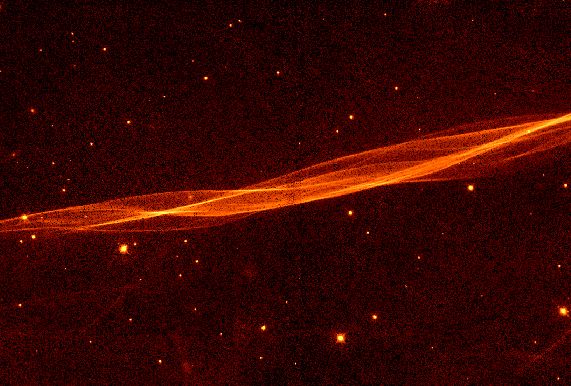Credit & Copyright: William P. Blair and Ravi Sankrit
(Johns Hopkins University),
NASA
Explanation:
Subtle and delicate in appearance, these are filaments of shocked
interstellar gas -- part of the expanding
blast wave from a violent stellar explosion.
Recorded in November 1997 with the
Wide Field and Planetary Camera 2
on board the Hubble Space Telescope,
the picture is
a closeup of a supernova remnant known as
the Cygnus Loop.
The nearly edge-on view shows a small portion of the
immense shock front
moving toward the top of the frame at about 170 kilometers per second
while glowing in light emitted
by atoms of excited hydrogen gas.
Not just another pretty picture, this particular image has
provided some
dramatic
scientific results.
In 1999, researchers used it to substantially revise downward
widely accepted estimates of distance and age for this classic
supernova remnant.
Now determined to lie only 1,440 light-years away, the
Cygnus Loop is
thought to have been expanding for 5 - 10 thousand years.
1999 2000 2001 2002 2003 2004 2005 2006 2007 2008 2009 2010 2011 2012 2013 2014 2015 2016 2017 2018 2019 2020 2021 2022 2023 2024 2025 |
Yanvar' Fevral' Mart Aprel' Mai Iyun' Iyul' Avgust Sentyabr' Oktyabr' Noyabr' Dekabr' |
NASA Web Site Statements, Warnings, and Disclaimers
NASA Official: Jay Norris. Specific rights apply.
A service of: LHEA at NASA / GSFC
& Michigan Tech. U.
|
Publikacii s klyuchevymi slovami:
Cygnus loop - supernova remnant - tumannost' petlya Lebedya - ostatok Sverhnovoi - udarnye volny
Publikacii so slovami: Cygnus loop - supernova remnant - tumannost' petlya Lebedya - ostatok Sverhnovoi - udarnye volny | |
Sm. takzhe:
Vse publikacii na tu zhe temu >> | |
